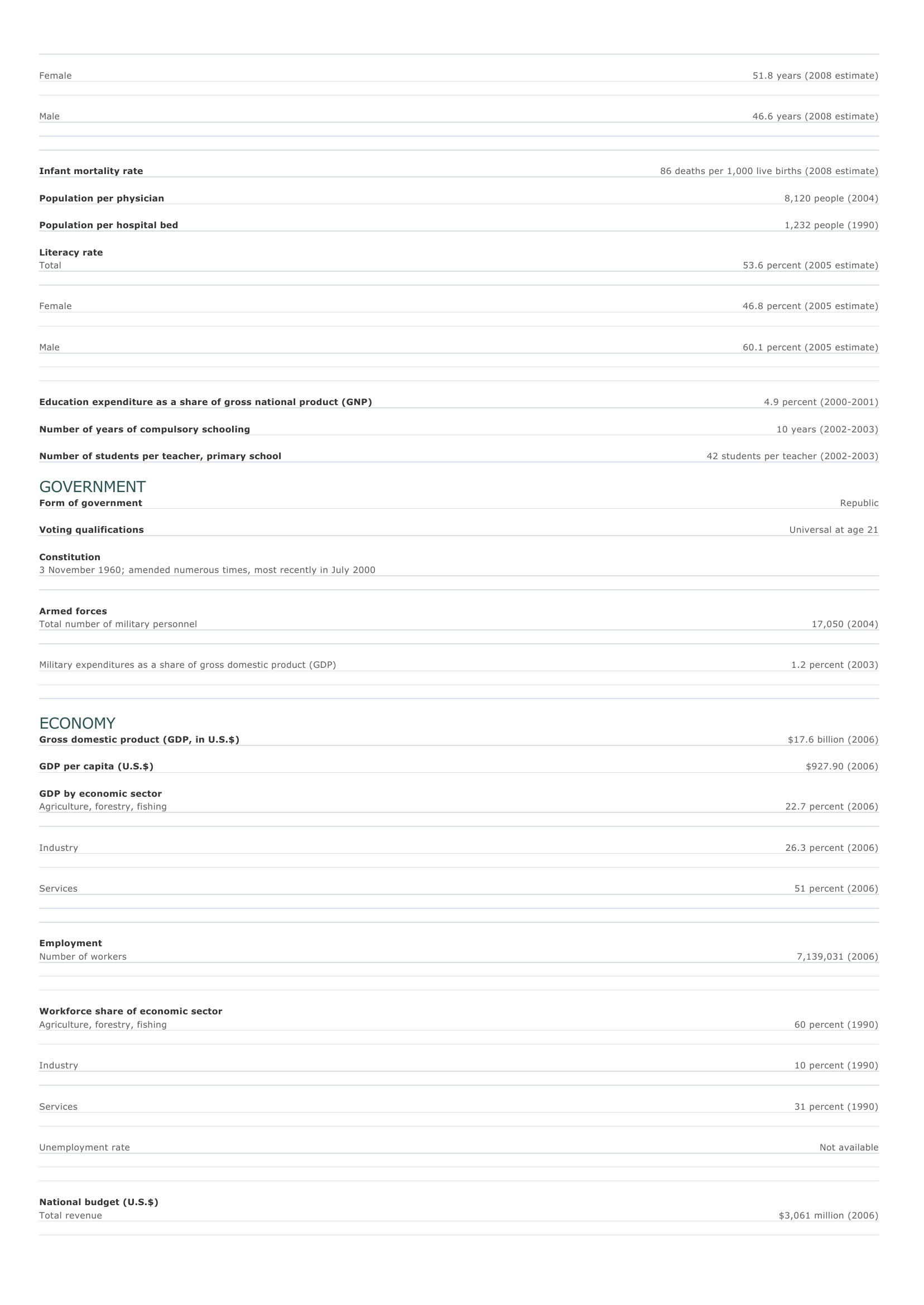Côte d'Ivoire Facts and Figures. BASIC FACTS Official name Republic of Côte d'Ivoire Capital Yamoussoukro NOTE: Although Yamoussoukro has been the country capital since 1983, Abidjan is still the legislative capital. Foreign governments maintain a presence in Abidjan. Area 322,462 sq km 124,503 sq mi PEOPLE Population Population growth Population growth rate 18,373,060 (2008 estimate) 1.96 percent (2008 estimate) Projected population in 2025 24,381,767 (2025 estimate) Projected population in 2050 32,400,664 (2050 estimate) Population density 58 persons per sq km (2008 estimate) 150 persons per sq mi (2008 estimate) Urban/rural distribution Share urban 46 percent (2005 estimate) Share rural 54 percent (2005 estimate) Largest cities, with population Abidjan 3,337,000 (2003 estimate) B ouaké 461,618 (1998) Daloa 173,107 (1998) Yamoussoukro Korhogo 416,000 (2003 estimate) 142,093 (1998) Ethnic groups There are some 60 groups, the largest of which are the Akan (Baule, Agni), Kru, Mande (Mandinke, Bambara), Senufo, Dan, Guro, Gagou, and Lobi. There are 2 million Burkinabe, 100,000 to 300,000 Lebanese, and 30,000 French. Languages French (official); Akan, Dioula, 60 native dialects Religious affiliations Indigenous beliefs 37 percent Muslim 30 percent Roman Catholic 15 percent Protestant 9 percent O ther 9 percent HEALTH AND EDUCATION Life expectancy Total 49.2 years (2008 estimate) Female 51.8 years (2008 estimate) Male 46.6 years (2008 estimate) Infant mortality rate 86 deaths per 1,000 live births (2008 estimate) Population per physician 8,120 people (2004) Population per hospital bed 1,232 people (1990) Literacy rate Total 53.6 percent (2005 estimate) Female 46.8 percent (2005 estimate) Male 60.1 percent (2005 estimate) Education expenditure as a share of gross national product (GNP) Number of years of compulsory schooling Number of students per teacher, primary school 4.9 percent (2000-2001) 10 years (2002-2003) 42 students per teacher (2002-2003) GOVERNMENT Form of government Republic Voting qualifications Universal at age 21 Constitution 3 November 1960; amended numerous times, most recently in July 2000 Armed forces Total number of military personnel Military expenditures as a share of gross domestic product (GDP) 17,050 (2004) 1.2 percent (2003) ECONOMY Gross domestic product (GDP, in U.S.$) GDP per capita (U.S.$) $17.6 billion (2006) $927.90 (2006) GDP by economic sector Agriculture, forestry, fishing 22.7 percent (2006) I ndustry 26.3 percent (2006) Services 51 percent (2006) Employment Number of workers 7,139,031 (2006) Workforce share of economic sector Agriculture, forestry, fishing 60 percent (1990) I ndustry 10 percent (1990) Services 31 percent (1990) Unemployment rate National budget (U.S.$) Total revenue Not available $3,061 million (2006) Total expenditure $3,331 million (2006) Monetary unit 1 Communaut* Financière Africaine (CFA) franc, consisting of 100 centimes Major trade partners for exports Netherlands, France, United States, Mali, and Ghana Major trade partners for imports France, Nigeria, United States, Italy, and Netherlands ENERGY, COMMUNICATIONS, AND TRANSPORTATION Electricity production Electricity from thermal sources 67.92 percent (2003 estimate) Electricity from hydroelectric sources 32.08 percent (2003 estimate) Electricity from nuclear sources 0 percent (2003 estimate) Electricity from geothermal, solar, and wind sources 0 percent (2003 estimate) Number of radios per 1,000 people 135 (2000 estimate) Number of telephones per 1,000 people 14 (2004) Number of televisions per 1,000 people 55 (2000 estimate) Number of Internet hosts per 10,000 people 2.3 (2003) Daily newspaper circulation per 1,000 people 16 (1996) Number of motor vehicles per 1,000 people 33 (1997) Paved road as a share of total roads 8 percent (2004) SOURCES Basic Facts and People sections Area data are from the statistical bureaus of individual countries. Population, population growth rate, and population projections are from the United States Census Bureau, International Programs Center, International Data Base (IDB) (www.census.gov). Urban and rural population data are from the Food and Agriculture Organization (FAO) of the United Nations (UN), FAOSTAT database (www.fao.org). Largest cities population data and political divisions data are from the statistical bureaus of individual countries. Ethnic divisions and religion data are largely from the latest Central Intelligence Agency (CIA) World Factbook and from various country censuses and reports. Language data are largely from the Ethnologue, Languages of the World, Summer Institute of Linguistics International (www.sil.org). Health and Education section Life expectancy and infant mortality data are from the United States Census Bureau, International Programs Center, International database (IDB) (www.census.gov). Population per physician and population per hospital bed data are from the World Health Organization (WHO) (www.who.int). Education data are from the United Nations Educational, Scientific and Cultural Organization (UNESCO) database (www.unesco.org). Government section Government, independence, legislature, constitution, highest court, and voting qualifications data are largely from various government Web sites, the latest Europa World Yearbook, and the latest Central Intelligence Agency (CIA) World Factbook. The armed forces data is from Military Balance. Economy section Gross domestic product (GDP), GDP per capita, GDP by economic sectors, employment, and national budget data are from the World Bank database (www.worldbank.org). Monetary unit, agriculture, mining, manufacturing, exports, imports, and major trade partner information is from the statistical bureaus of individual countries, latest Europa World Yearbook, and various United Nations and International Monetary Fund (IMF) publications. Energy, Communication, and Transportation section Electricity information is from the Energy Information Administration (EIA) database (www.eia.doe.gov). Radio, telephone, television, and newspaper information is from the United Nations Educational, Scientific and Cultural Organization (UNESCO) database (www.unesco.org). Internet hosts, motor vehicles, and road data are from the World Bank database (www.worldbank.org). Note Figures may not total 100 percent due to rounding. Microsoft ® Encarta ® 2009. © 1993-2008 Microsoft Corporation. All rights reserved.

















